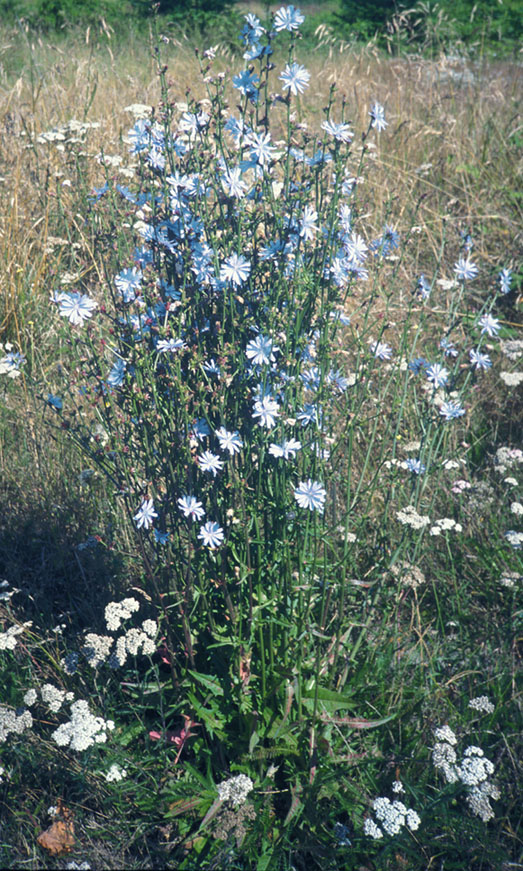
|
| Chicory; Cichorium Intybus L. |
Sunflower Family; COMPOSITÆ (ASTERACEÆ)
|
| Minorities always attract attention. If chicory flowers were yellow rather than sky-blue, it would surely be held in less esteem, be
less known, and perhaps be less common. So many chicory relatives have yellow flowers that it is indeed a pleasing anomaly in its
vivid blueness. By late July and August, when fields and meadows are yellow and brown, it is a joyful blue contrast. |
| Chicory is from the Old World, and its names, Latin and English, derive ultimately from Arabic. It is closely related
to endive. Other names include wild endive, blue sailors, blue daisy, coffeeweed, bunk, and succory. |
| A long-lived, robust perennial herb, chicory begins each year with a flush of rank, soft greenery in late spring, soaring up
3 to 8 feet tall in July, and bears its lovely but sparse flowers from mid-June until late October. Each blue flower is about 1 to 2
inches wide, on a rigid, wandlike stem. The leaves nearest the ground are bold, softly downy, coarsely scalloped, to 12 inches long,
and reminiscent of those of a robust dandelion. The roots are deep, white, and bitter. |
| Chicory grows best in full sun, and endures even dry, sterile sites. Companions include fennel, Queen Anne's lace,
St. John's-wort, tansy, mugwort, goldenrod, oxeye daisy,
etc. It is not liable to be confused with any other plant so long as it is in
bloom. A certain wild lettuce also has blue flowers, but is exceedingly rare in Seattle, and in other details differs. |
| Although very bitter, it is edible. If you have a strong mouth, and gather the youngest leaves in spring, they will serve as
raw salad fare. Blanched, or cooked, they are less jolting. For my part, I prefer to eat chicory relatives which supply similar nutrition
and flavor with less bitterness. For example, nipplewort (Lapsana communis), cat's ear (Hypochæris radicata), salsify (Tragopogon porrifolius), and sow-thistle (Sonchus oleraceus). |
| Coffee-drinkers may want to dig some chicory roots, dry them, and use them as a substitute for your drink. Finding
coffee foul, I try nothing reputed coffee-like. |
| Herbalists use chicory. It is not stellar in its abilities, although was selected as one of Dr. Bach's flower remedies.
Its primary attributed properties are diuretic, tonic, and stomachic. |
In the Language of Flowers it signifies frugality.
|
Originally published as the Seattle Tilth newsletter Weed of the Month in January 1995, along with an illustration from a book.
Back |
|
|

